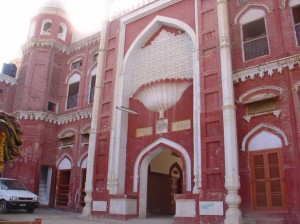Bhera: A Historical City Lost in Obscurity-Last part
Thursday, April 12th, 2012 10:49:35 by Naveed A Bari
Bhera: A Historical City Lost in Obscurity-Last part
1300 years ago, Bhera was a place of learning and people from other areas came here to learn about medicine and geography. Besides many Muslim saints passed by Bhera which became famous in the whole of Asia. Hazrat Meeran Sahib was one such saint, who worked
for the transmission of Islam in the area. His shrine is located in the western part of the town near river Jhelum.
People from different parts of the area visit his shrine to pay homage. Businessmen and scholars arrived first and then Gaznavi, Ghori, Aibak, Babur and Ahmed Shah Abdali passed by the city to attack the great Rajas and Marathas. During Mughal period, caravans
from Central Asia, Kabul, Qandahar and Peshawar used to cross the river to go to Lahore, Delhi and other parts of India. Caravans from Kashmir used to reach Bhera along with the river.
During the reign of Mughal emperor Akbar, Bhera had a royal mint for minting gold and silver coins. Bhera remained famous in handicrafts and cottage industry , daggers , sword , cutlery , walking sticks , wooden furniture , carved doors , cotton blankets
, silk loin cloth, hand fans , earth pottery and edible delicacies.
During English period , Bhera was so renowned for wood carving that carpenters from here were taken to England to carve some of the doors of Buckingham Palace. Today Bhera is known for its Mehndi (Lawsonia Alba) , Phainian and Pateesa.
Like all old cities, Bhera was also built as a fortified city with eight gates around the city namely Multani Gate, Lahori Gate, Kashmiri Gate, Kabuli Gate, Peeranwala Gate, Chinioti Gate, Loharanwala Gate and Hajji Gulab Gate. Only four gates have been
able to survive to date, Peeranwala Gate, Hajji Gulab Gate, Loharanwala Gate and Qabli Gate are damaged now.
During the excavation of the Greek city of Bhera by Dr M Salim of the Taxila Institute of Asian Civilizations, many a artifacts of iron age, Achaemenian, Greek and Maurayan period have been found. Painted pottery dating from 800-600 BC and a terracotta elephant
have also been found. Soak wells, 10-feet high, were found in Bhir mound.
Today, this once thriving city lies in shambles and has been utterly neglected. The old buildings have been dilapidated, especially after the 1992 floods, when the whole city was submerged under many feet of water that eroded walls and roofs of havelis.
It is a misfortune that there is no official or public awareness about the treasure of the past.
Short URL: https://www.newspakistan.pk/?p=18757

















